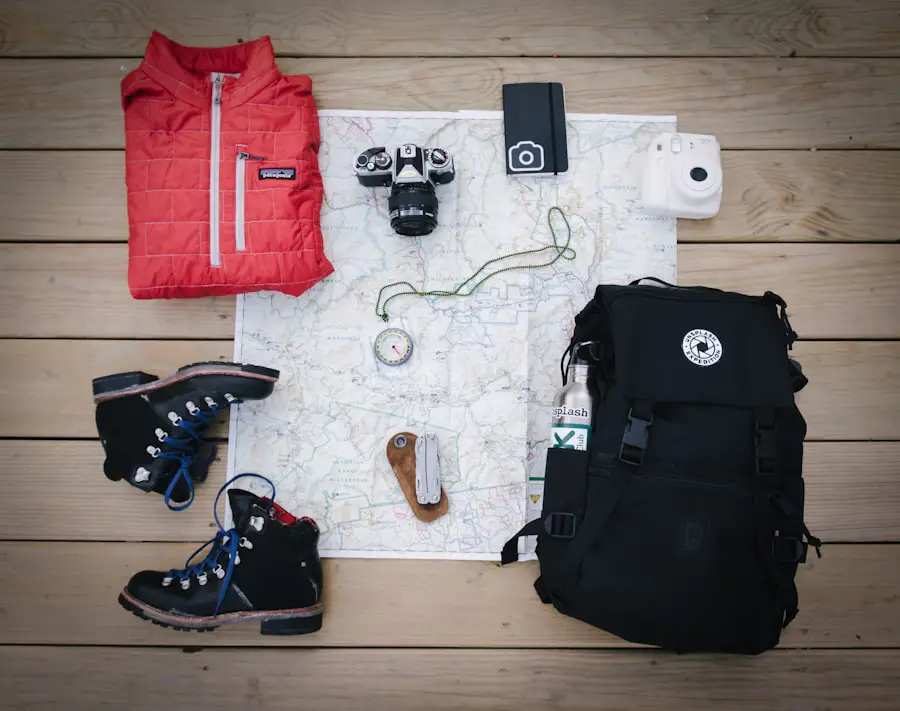When embarking on a hiking adventure, the significance of appropriate attire cannot be overstated. Proper hiking clothing serves as a protective barrier against the elements, ensuring that hikers remain comfortable and safe throughout their journey. The right attire not only enhances the overall experience but also plays a crucial role in preventing injuries and discomfort.
For instance, wearing moisture-wicking fabrics can help regulate body temperature by drawing sweat away from the skin, which is essential during strenuous activities. Conversely, cotton clothing retains moisture, leading to chafing and hypothermia in cooler conditions. Moreover, the psychological aspect of wearing suitable hiking attire should not be overlooked.
When hikers feel comfortable and well-equipped, they are more likely to enjoy their surroundings and focus on the beauty of nature rather than being distracted by discomfort. This mental clarity can enhance the overall experience, allowing individuals to immerse themselves fully in the adventure. Additionally, proper attire can instill a sense of preparedness, which is vital for tackling unexpected challenges that may arise on the trail.
Key Takeaways
- Proper hiking attire is important for comfort, protection, and safety during outdoor activities.
- Choosing the right footwear is crucial for preventing blisters, providing support, and maintaining stability on different terrains.
- Layering clothing for hiking provides flexibility and protection against changing weather conditions.
- Selecting the best fabric for hiking clothing involves considering moisture-wicking, breathability, and durability.
- Essential accessories for hiking include hats, sunglasses, sunscreen, and insect repellent for added protection and comfort.
Choosing the Right Footwear for Hiking
Footwear is arguably one of the most critical components of hiking attire. The right pair of hiking boots or shoes can make a significant difference in both comfort and safety on the trail. When selecting footwear, it is essential to consider factors such as terrain, distance, and personal comfort preferences.
For instance, if one plans to hike on rocky or uneven terrain, a sturdy pair of boots with excellent ankle support is advisable. These boots often feature rugged outsoles designed to provide traction and stability, reducing the risk of slips and falls. In addition to support and traction, fit is paramount when choosing hiking footwear.
Ill-fitting shoes can lead to blisters, calluses, and other foot ailments that can quickly derail a hiking trip. It is recommended to try on hiking shoes with the socks intended for use during hikes, as this can affect the fit significantly. Furthermore, considering the break-in period is crucial; new boots should be worn on shorter walks before embarking on longer hikes to ensure they are comfortable and do not cause discomfort.
Layering for Comfort and Protection

Layering is a fundamental principle in outdoor clothing that allows hikers to adapt to changing weather conditions while maintaining comfort. The layering system typically consists of three main layers: a base layer, an insulating layer, and an outer shell. The base layer is designed to wick moisture away from the skin, keeping the hiker dry and comfortable.
Materials such as merino wool or synthetic fabrics are popular choices for this layer due to their moisture-wicking properties and ability to regulate temperature. The insulating layer serves to retain body heat, which is particularly important in cooler conditions. Fleece jackets or down vests are common options for this layer, providing warmth without excessive bulk.
Finally, the outer shell protects against wind, rain, and other environmental factors. Waterproof and breathable materials like Gore-Tex are ideal for this layer, as they keep moisture out while allowing sweat to escape. By utilizing this layering system, hikers can easily adjust their clothing based on activity level and weather changes, ensuring optimal comfort throughout their trek.
Selecting the Best Fabric for Hiking Clothing
| Fabric Type | Pros | Cons |
|---|---|---|
| Merino Wool | Natural, moisture-wicking, odor-resistant, temperature regulating | Expensive, can be less durable |
| Synthetic (Polyester, Nylon) | Durable, quick-drying, affordable | Less breathable, can retain odor |
| Cotton | Comfortable, affordable | Retains moisture, slow to dry, not suitable for cold weather |
| Bamboo | Soft, breathable, eco-friendly | Less durable, can shrink in hot water |
The choice of fabric plays a pivotal role in the performance of hiking attire. Different materials offer varying benefits and drawbacks that can significantly impact a hiker’s experience. Synthetic fabrics such as polyester and nylon are popular choices due to their lightweight nature and quick-drying capabilities.
These materials are particularly advantageous in wet conditions or during high-intensity activities where sweat accumulation is likely. Natural fibers like wool and cotton also have their place in hiking attire but come with specific considerations. Wool is renowned for its insulating properties and moisture-wicking abilities, making it an excellent choice for base layers.
However, cotton should generally be avoided for hiking purposes; while it is comfortable in dry conditions, it retains moisture and can lead to chilling when wet. Understanding these fabric characteristics allows hikers to make informed decisions about their clothing choices based on the specific demands of their hike.
Essential Accessories for Hiking
In addition to clothing and footwear, various accessories can enhance a hiker’s experience and provide additional comfort and protection. A well-fitted hat is essential for shielding the face from sun exposure while also helping to regulate body temperature. Wide-brimmed hats offer maximum coverage, while caps with neck flaps provide extra protection against UV rays.
Another critical accessory is a good pair of hiking socks. Investing in high-quality socks made from merino wool or synthetic blends can prevent blisters and keep feet dry during long hikes. Additionally, gloves and gaiters can be beneficial in colder or muddy conditions, providing extra warmth and protection against debris.
A lightweight backpack is also essential for carrying water, snacks, and other necessities without adding excessive weight or bulk.
Considerations for Different Weather Conditions

Staying Comfortable in Warm Weather
In hot weather, lightweight and breathable fabrics are crucial for maintaining comfort and preventing overheating. Light-colored clothing can also help reflect sunlight, reducing heat absorption. Additionally, wearing a wide-brimmed hat and sunglasses can protect against harmful UV rays.
Dressing for Cold Weather
Conversely, cold weather requires a different approach to attire. Insulating layers become vital for retaining body heat, while waterproof outer layers protect against wind and precipitation.
Preparing for Slippery Surfaces
It’s also important to consider the potential for snow or ice; traction devices such as microspikes can be added to footwear for enhanced grip on slippery surfaces. Understanding how to adapt clothing choices based on weather forecasts ensures that hikers remain safe and comfortable regardless of environmental challenges.
Hiking Attire for Safety and Protection
Safety should always be a top priority when selecting hiking attire. In addition to choosing appropriate footwear and clothing layers, visibility is an essential consideration. Brightly colored clothing or reflective materials can enhance visibility in low-light conditions or dense forested areas, making it easier for others to spot hikers during emergencies.
Furthermore, protective clothing can guard against environmental hazards such as thorny bushes or insect bites. Long-sleeved shirts and pants made from durable materials can provide an extra layer of defense against scrapes and bites from insects like ticks or mosquitoes. In areas known for wildlife encounters, wearing neutral colors may help avoid attracting unwanted attention from animals while still providing necessary protection.
Tips for Maintaining and Caring for Hiking Attire
Proper maintenance of hiking attire is crucial for ensuring longevity and performance over time. Washing techniques play a significant role in preserving the integrity of technical fabrics; it’s advisable to follow manufacturer instructions regarding washing temperatures and detergents. Many outdoor fabrics benefit from specialized detergents designed to maintain moisture-wicking properties while avoiding fabric softeners that can clog pores.
Additionally, storing hiking gear properly can prevent damage from environmental factors such as moisture or pests. Keeping clothing in a cool, dry place away from direct sunlight helps maintain fabric quality over time. Regularly inspecting gear for signs of wear or damage allows hikers to address issues before they become significant problems, ensuring that all equipment remains reliable when it’s time to hit the trails again.
By understanding the importance of proper hiking attire and making informed choices regarding footwear, layering systems, fabric selection, accessories, weather considerations, safety measures, and maintenance practices, hikers can significantly enhance their outdoor experiences while ensuring comfort and protection throughout their adventures in nature.
If you are planning a hiking trip, it is important to consider what to wear to ensure your comfort and safety on the trail. One related article that may be of interest is the best lightweight laptop for travel. This article provides recommendations for portable laptops that are perfect for taking on your outdoor adventures. Having a lightweight laptop can be useful for staying connected while hiking, allowing you to document your journey or stay in touch with loved ones.
Love travel? Join Our Facebook Community For More Tips.
FAQs
What should I wear for hiking?
When going hiking, it’s important to wear moisture-wicking clothing to keep you dry and comfortable. This includes a moisture-wicking base layer, a breathable and lightweight shirt, and quick-drying pants or shorts. It’s also important to wear sturdy and supportive hiking boots or shoes.
What type of socks should I wear for hiking?
For hiking, it’s best to wear moisture-wicking socks that are made of wool or synthetic materials. These types of socks will help keep your feet dry and prevent blisters.
Should I wear a hat when hiking?
Wearing a hat while hiking is a good idea, especially if you’ll be exposed to the sun for long periods of time. A wide-brimmed hat can help protect your face and neck from the sun’s rays, while a beanie or cap can keep you warm in cooler weather.
What kind of outerwear should I bring for hiking?
It’s important to bring a waterproof and windproof jacket or shell when hiking, as weather conditions can change quickly. Look for a jacket that is lightweight and packable so you can easily stow it in your backpack when not in use.
Are there any specific clothing items to avoid when hiking?
Avoid wearing cotton clothing when hiking, as it retains moisture and can lead to chafing and discomfort. Instead, opt for moisture-wicking and quick-drying materials to keep you comfortable on the trail.
